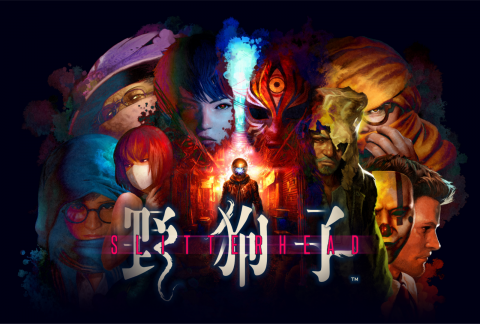
Keiichiro Toyama will probably be known entirely as the man who created Silent Hill. Everything else will be swallowed up by that one fact, despite all the interesting projects he’s worked on and led. The Siren games took a similar horror slant but with unique gameplay ideas and a harder lean into eldritch horror, while the Gravity Rush games were a refreshing change of pace of heroic adventures that could show what the Vita was able to do. People seemed to only remember that first directorial project when his first independent project with various former Japan Studio devs came to light. Under the name Bokeh Game Studio, founded after feeling there wasn’t really a place for their ideas in Sony’s growing focus on AAA budgets, Toyama and his fellow creatives would end up releasing Slitterhead to confused responses, though starting to slant more positive. Despite all of the advertising promising something new and unique, some came into this expecting another Silent Hill.
Instead of that, they got a janky, scantly budgeted ode to the directorial work of Wong Kar-wai, the manga Parasyte, and also a bit of the Siren games is you squint hard enough.

Slitterhead is one of the most inexplicable games to come out from an established group of developers in quite some time, and that is so refreshing. In an industry currently burning down vast swaths of the middle market, appropriating niche interests and styles with bigger teams, and bloating large scale projects into doomed to fail live services, the existence of a game like this feels alien. It genuinely feels like something from the experimental era of the PS2 and PS3, but with some future influence of Fromsoft’s impact on action games, mainly making parries the default action game mechanic of the day. While you can pick out pieces of this game as clearly inspired by someone else, the collective end result is unlike anything else out there, and manages to nail a lot of what it’s attempting.
The story starts off simply enough, as you are given control of a lone spirit eventually given the name Night Owl. He doesn’t remember much about himself besides a single clear thought: He has to eliminate the monsters known by Hong Kong’s people as “slitterheads.” They’re horrific creatures with some form of human intelligence gathered from feeding on human brains with straw like appendages, using dehydrated human bodies as skin suits for their true forms, disturbing mixtures of aquatic and insect life (much like the monsters in the Siren games).

To do this, Night Owl has to chase them down and fight them via the people of Hong Kong themselves, able to possess them and create weapons from their blood. However, his real power only comes out when possessing a rarity, a human with a strong will who can sync with him and give access to even greater weapons and powers based on their given personalities. This starts with a girl named Julee, and eventually spreads into a collection of strangers across the city as a functional monster hunting unit.
Oh, and they’re in a three day time loop Night Owl can go back and forth in, which he needs to do in order to figure out what that dream he had with Julee when they first met showing three slitterheads floating above a burning city means and how to avoid that future. The plot only gets much, much more complicated from there.

Slitterhead starts out simple enough, but layers on twists and surprises that fundamentally change the context of the entire adventure on its head. The fact that it locks some of this context behind a made up language you have to decipher via Night Owl’s collectible memories would normally be something to complain about, as we have seen so many games lock context behind overly written lore dumps in the menu, but the piecing together the details angle actually works due to the functionally complicated places the plot goes. Yet, it never sacrifices character and emotion for it, each of the rarities being at least likable, or surprisingly layered as you talk with them after missions.
The writing is doing a lot of heavy lifting in this department due to the game’s limited budget. Voice acting is technically in the game, but only in a small handful of show stopper cutscenes. Most dialog will be read in subtitles as grunts or a random, barely connected line is spoken by the character’s actor to create some sort of mood of being in the thoughts of a character to match with Night Owl’s detached existence. This doesn’t work as well during missions, where dialog is happening entirely through text while you’re fighting, or things stop awkwardly for still shots as you go through text boxes without the boxes, bringing to mind Yakuza 6‘s iffy side stories without the voice acting.

Presentation as a whole is kind of all over the place. Alongside the lacking voice acting the game could have really benefited from having more of (what is there is quite good), there’s a pretty stark difference between regular civilians and significant characters. Everyone is an exaggerated character of some sort, but while rarities and major characters get complex designs and expressive faces, all of the normal people are aggressively normal, to the point there’s less graphical details in their models, even though they can show up in the many in-engine cutscenes.
It’s occasionally off-putting, but other times genuinely charming in how out of place it is. They just look very out of place against actual named characters, especially when main rarities Julee and Alex are clearly designed off of actors in Chungking Express and Fallen Angels (Faye Wong and Leon Lai). The main cast all look like they sprung from beautifully shot movies and anime, while the normies look like people you pass on the street every day.

While the game couldn’t reach any sort of open world status, using limited sections of a fictional version of Kowloon called “Kowlong” set sometimes in the 90s, it makes the most of what it has. The city looks lively and detailed in all the right spots, especially the use of lit up signs you can jump around on via blood tethers. The slitterheads themselves also have fascinating designs, detail in just about every aspect of how they could possibly work on a biological level. It makes reading their attack animations manageable, despite being otherwise so busy looking.
Akira Yamaoka also returned to work with his old college, sneaking in an odd Silent Hill style track here and there, but otherwise flexing his muscles and trying all sorts of things, including some powerful drone pieces. The highlight is definitely the game’s intro song, though. Blood Snow is one of the most haunting tracks the man has ever done, while still being catchy to the point you could almost dance to it. The fact you’ll first hear it directly after the game’s unhinged title screen music just makes its effect hit all the harder.

As for the actual game part of Slitterhead, it is both something conventional and something very unique, at least on the scale and production value it’s working at. Much of the game is fighting monsters, with weighty animations behind every move you have to keep in account, and some expected systems. Dodge moves, blocking, weapon durability you gain back through successful parries of enemy attacks, ect. The game also has a visual highlight to warn of what direction you need to tilt the stick to make the parry, though you will need to watch enemy animations to get the timing down, which rewards tighter parry times. All the expected stuff you’d see in a post Dark Souls era of gaming. But remember, you’re playing as a possessing spirit, which means you aren’t just using one body.
Where Slitterhead becomes a blast is how hard the team leaned into the possession mechanic. At any time, you can hold down a button and enter a slowed down state as you scan around the area and find the next person to possess. This isn’t just a gimmick, like you’d normally get from games with possession mechanics – it’s the crux of the entire combat system. Switching bodies lets you attack enemies from different angles, even getting bonuses from chaining possessions for quick hit and run attacks. The rarities even mix into this system with their unique powers, Night Owl able to use one from each of the two rarities on the mission with normal civilian bodies.

Rarities themselves get higher stats you can put points into, plus unique and more powerful weapons. They also come with three unique powers, offering different play styles and some synergy with each other on missions. Everyone is generally set for a certain role in a duo, outside the balanced Julee you start the game meeting, so the idea is that you make different pairs based on what you feel you need to finish a mission. For example, Blake’s blood guns make him able to melt the health bars of fully revealed slitterheads, but struggles with crowds and blood usage, these powers using the blood of the body itself and therefore its health. A rarity with useful support abilities, like Anita being able to attract more people to the area or Tri’s ability to buff herself to make her hits cause more blood pools on the ground, make a good match with him as a result.
It’s a good system, with plenty of options. More technical minded action game fans might gravitate towards Edo in particular, for his self buffing and low cost dodge dash with invincibility frames. Anita will appeal to those who prefer to step back and let others do the work, not only able to summon people but put them in a frenzy to pile on an enemy. These characters are also introduced at a good pace, each new rarity starting to show more depth hidden behind the initial systems before it really starts to click as the slitterhead mobs get larger and larger.

Mission design also tries to add some variety with exploration scenarios, having characters track down a given target or explore a specific area. This helps the action from being too overwhelming, as it can get stressful in the late game, even if a lot of this are clear leftovers from an earlier point in development where this might have been open world. It gives the game some character and the world it’s set in life. There’s even collectible through costume items and Night Owl’s memories, which give a slosh of extra skill points for your rarities.
It also cultivates personality through its clear love for Hong Kong cinema, including a near shot-for-shot remake of the motorcycle tunnel sequence from Fallen Angels at game’s start. This results in a unique action horror experience. The Parasyte elements with the monsters hiding among us and this ongoing vibe of tokusatsu earnest silliness really completes the picture, equal parts ridiculous cartoon and a love letter to a city as it was presented in 90s pop culture. It feels like a Like A Dragon or Grand Theft Auto style experience of presenting a real space put through the nightmare lens that will feel very familiar for Siren veterans.

The game’s bizarre nature definitely helps a lot with this. There are full conversations with the surprisingly goofy slitterheads, really leaning into how odd their human qualities are with their horrific appearances. The morbid and underplayed elements of the possession mechanic of the game are also often leaned into via Night Owl’s lacking humanity early on. It’s not often a tutorial makes you jump someone off a building before surfing to another body mid-air, while all of the normal people below are understandably horrified by what just happened as Night Owl struggles to move around his newest meat puppet. It is equal parts shocking and darkly funny.
If you’re a fan of that experimental age of the mainstream game industry, especially on Japan’s side of things, you need to play Slitterhead. It exists in the same sort of spirit that lead to inexplicable experiences like Breakdown, Phantom Dust, Killer7, and the original Yakuza. At the same time, there’s a great deal of industry experience here, making the most of the limited resources the team had on hand, and it pays off if you can put up with some jank and poor early game tutorials (especially Alex’s recruitment mission). This is not another Silent Hill, this is something new and unique, with a spirit that’s becoming very rare for this medium.
Slitterhead was first posted on October 16, 2025 at 9:00 am.
©2017 "Hardcore Gaming 101". Use of this feed is for personal non-commercial use only. If you are not reading this article in your feed reader, then the site is guilty of copyright infringement. Please contact me at kurt@hardcoregaming101.net




